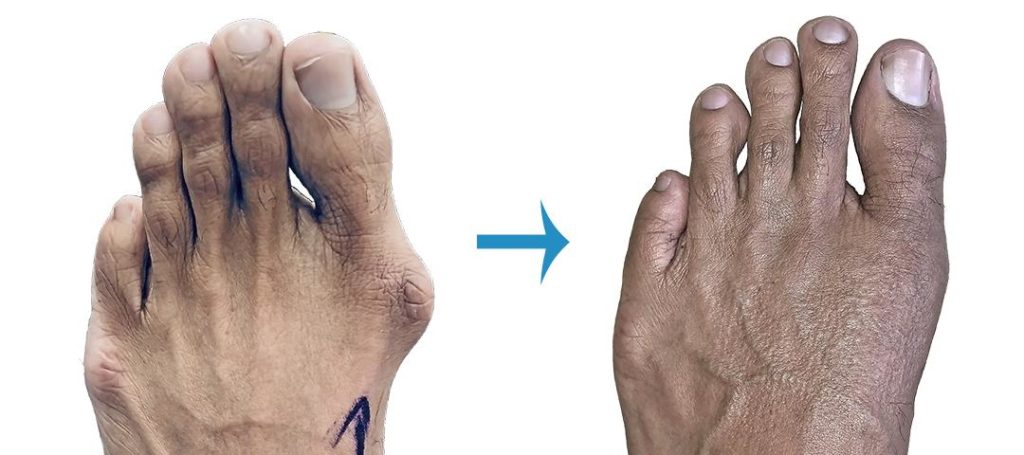Bunion Surgery Recovery Tips Week by Week
10th Feb 2020
Bunion Surgery
A Bunion is a common foot deformity that manifests as a bony growth below the base of the big toe. A Bunion is progressive, meaning it will get worse over time; the Bunion ‘bump’ will enlarge and often causes footwear fitting issues, pain, swelling and can prevent day-to-day activities. We have previously written some detailed information about Bunions and how to recognise them.
Surgical correction of Bunions tend to be considered a last resort when more conservative treatment measures fail to resolve the symptoms. This is partly because, like most types of surgery, it requires a recovery period and patients are often concerned this will be disruptive. However, in recent years Bunion surgery techniques have improved, greatly reducing the impact and length of recovery from an operation.
Recovery for bunion surgery
The recovery will vary depending on the type of procedure that is advised, although they often share many characteristics and stages, including:
- Physical therapy: this is an
important part of the recovery process to make sure healing and the return to
activity is optimal. Usually this will begin at around two weeks after surgery. - Post operative shoes: all
patient will wear protective shoes and slowly transition back to normal
footwear - Swelling: will reduce over time
and be much improved from 6 weeks.
Below is some key information on these and other aspects of the recovery.
Bunion surgery recovery time
Recovery times following Bunion surgery can
vary, depending on a number of factors:
- General health: older patients
or have generalised health conditions, like diabetes, may need a longer period
to fully heal - Type of procedure: the less
invasive the procedure the faster and less impactful the recovery. For example,
with Minimally Invasive Bunion Surgery it is possible to walk straight away,
albeit with less activity and some reasonable supports during the appropriate
stages. However, Minimally Invasive Procedures are not always appropriate. - Other surgeries: if operations
for other deformities are conducted at the same time, this may impact the
overall recovery period.
However, for the most common types of
operation and assuming normal levels of health, the recovery times broadly
follow the below pattern:
- The first 2-4 days | You should
rest as much as possible with your feet up over this period; restricting
movement to using the bathroom. Generally all movement will make use of some
kind of support, such as crutches. - 2 weeks after surgery |
Bandages will likely no longer be needed. Many patients return to trainers and
may start with physiotherapy at this point. - 2-6 weeks after surgery |
Patients often return to work during this period. You can return to driving on
the condition that you can perform an emergency stop. Virtually all normal
activities are possible at this point. - 6-12 weeks after surgery |
Sports and other shoe types can be returned to over this period. - 6 months after surgery | You
will normally have a final review around this period. By his point you should
have the full benefit of the surgery.
A particular recovery pathway may differ
from the above in some respects and your surgeon will always be able to advise what
to expect in a more specific case.
Bunion Surgery Recovery Tips By Mr. Kaser Nazir (Consultant Podiatric Surgeon)
Recovery shoes
Normally patients will make use of a
postoperative shoe over the first two weeks postoperatively. These look like
slightly oversized sandals that redistribute pressure away from the surgery
site when moving, as well as protect the area from knocks.
Sometimes, if a swift return to work is
important, patients may make use of an aircast boot, which provides added protection
as well as control of swelling.
Bunion surgery recovery exercises
It is important to maintain strength after
a period of limited activity, as well as to relieve pain. The recovery will
involve both strengthening and stretching exercises.
Strength: these will be targeted exercises
to gradually improve strength of the muscles that support your foot and lower
limbs. This will help keep your joints stable, as well as relieve some foot and
ankle pains that are caused by weakness.
Stretching: Improving flexibility of your
lower limb muscles can help restore the range of motion of your foot &
ankle, as well as reduce muscle soreness.
A physiotherapist will aid and guide
patients through this process.
Bunion surgery – before and after
What to expect

Click here to see more Before and After Surgery Images
When to contact a doctor during recovery
Your surgeon will warn you of any signs to
watch out for and how to act should there be any concerns during a recovery. It
is important to seek specialist advice or revert to your surgeon if you notice
any of the following:
- Excessive low limb swelling,
which could indicate a DVT - Allergic reaction to anesthesia
- Infection, indicated by pus,
pain, increased temperature and swelling - Pain controls, such as
medication, are not working
Get in touch
If you have any other questions or would
like to reserve an appointment, don’t hesitate to get in touch with our team:



